There are some really good Ansible books around to help you solidify Ansible concepts and help you on your journey to be an Ansible expert! When studying IT related topics, there are always a lot of great resources available, including Ansible tutorials and blog posts, online training courses, code repositories, ebooks, online documentation, videos and more! But sometimes it’s great just to hold a book in your hands, and get offline for a while. With that in mind, here are some of the great Ansible books around at the moment. I focused the list on new Ansible books, which have been released from 2017 onwards, but in the main have been released in the last two years.

Ansible for DevOps: Server and configuration management for humans
Ansible is a simple, but powerful, server and configuration management tool (with a few other tricks up its sleeve). This book will help those familiar with the command line and basic shell scripting start using Ansible to provision and manage anywhere from one to thousands of servers.
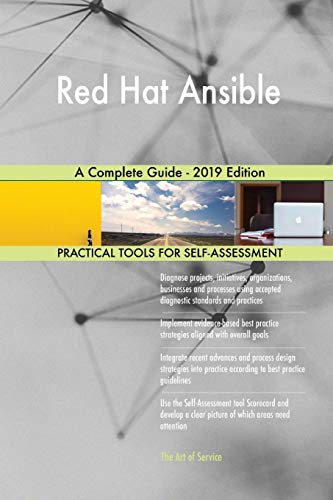
Red Hat Ansible A Complete Guide
What are the benefits of piloting a trial version of a software application? Is it clear for what platforms the software is written? What types of tasks are or would be the top priorities for security analytics and operations automation and/or orchestration? Why is it better than other provisioning technologies? How can you get automated regression tests in place quickly? This breakthrough Red Hat Ansible self-assessment will make you the entrusted Red Hat Ansible domain specialist by revealing just what you need to know to be fluent and ready for any Red Hat Ansible challenge.
How do I reduce the effort in the Red Hat Ansible work to be done to get problems solved? How can I ensure that plans of action include every Red Hat Ansible task and that every Red Hat Ansible outcome is in place? How will I save time investigating strategic and tactical options and ensuring Red Hat Ansible costs are low? How can I deliver tailored Red Hat Ansible advice instantly with structured going-forward plans? There’s no better guide through these mind-expanding questions than acclaimed best-selling author Gerard Blokdyk. Blokdyk ensures all Red Hat Ansible essentials are covered, from every angle: the Red Hat Ansible self-assessment shows succinctly and clearly that what needs to be clarified to organize the required activities and processes so that Red Hat Ansible outcomes are achieved. Contains extensive criteria grounded in past and current successful projects and activities by experienced Red Hat Ansible practitioners. Their mastery, combined with the easy elegance of the self-assessment, provides its superior value to you in knowing how to ensure the outcome of any efforts in Red Hat Ansible are maximized with professional results. Your purchase includes access details to the Red Hat Ansible self-assessment dashboard download which gives you your dynamically prioritized projects-ready tool and shows you exactly what to do next. Your exclusive instant access details can be found in your book. You will receive the following contents with New and Updated specific criteria: – The latest quick edition of the book in PDF – The latest complete edition of the book in PDF, which criteria correspond to the criteria in… – The Self-Assessment Excel Dashboard – Example pre-filled Self-Assessment Excel Dashboard to get familiar with results generation – In-depth and specific Red Hat Ansible Checklists – Project management checklists and templates to assist with implementation INCLUDES LIFETIME SELF ASSESSMENT UPDATES Every self assessment comes with Lifetime Updates and Lifetime Free Updated Books. Lifetime Updates is an industry-first feature which allows you to receive verified self assessment updates, ensuring you always have the most accurate information at your fingertips.
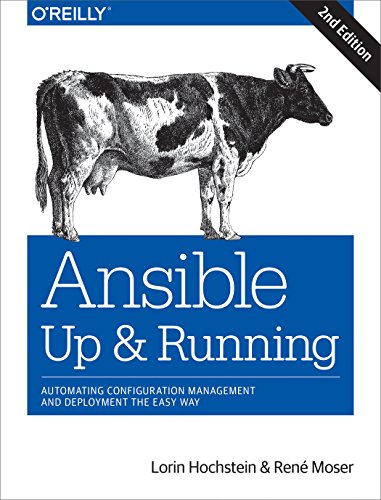
Ansible: Up and Running
Among the many configuration management tools available, Ansible has some distinct advantages—it’s minimal in nature, you don’t need to install anything on your nodes, and it has an easy learning curve. With this updated second edition, you’ll learn how to be productive with this tool quickly, whether you’re a developer deploying code to production or a system administrator looking for a better automation solution.Authors Lorin Hochstein and René Moser show you how to write playbooks (Ansible’s configuration management scripts), manage remote servers, and explore the tool’s real power: built-in declarative modules.
You’ll discover that Ansible has the functionality you need—and the simplicity you desire.Manage Windows machines, and automate network device configurationManage your fleet from your web browser with Ansible TowerUnderstand how Ansible differs from other configuration management systemsUse the YAML file format to write your own playbooksWork with a complete example to deploy a non-trivial applicationDeploy applications to Amazon EC2 and other cloud platformsCreate Docker images and deploy Docker containers with AnsibleThis book is best read start to finish, with later chapters building on earlier ones. Because it’s written in a tutorial style, you can follow along on your own machine. Most examples focus on web applications.
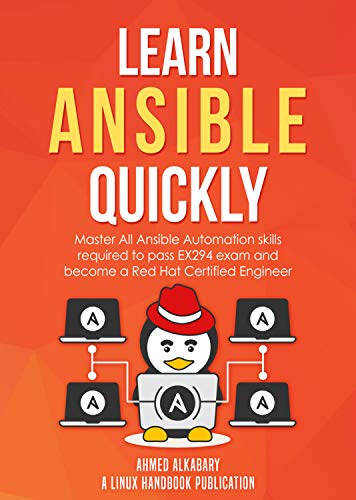
Learn Ansible Quickly
Master Ansible Automation and learn how to automate your apps deployment and IT infrastructure operations.Ansible is one of the most popular DevOps tools available in the IT market.Key FeaturesRun Ansible Ad-Hoc commands.Deploy Files with Jinja2 templates.Create and run Ansible Playbooks.Use Ansible Vault to protect sensitive information.Use Ansible Galaxy to install and use Ansible roles.Learn various Ansible troubleshooting techniques.Book DescriptionLearn Ansible Quickly is a fully practical hands-on guide for learning Ansible Automation. It will get you up and running with Ansible in no time.
First, you will break the ice with Ansible by running very simple Ad-Hoc commands. Then, you will dive into the world of Ansible playbooks, variables, facts, registers, and loops. Also, you will learn how to use conditional statements in your Ansible playbooks. Moreover, you will explore how to use blocks to handle exceptions and failures in Ansible. In addition, you will get to install and use Ansible roles, so your playbooks look clean and unrepetitive. Finally, you will learn various troubleshooting techniques in Ansible.By the end of this book, you will have all the skills necessarily to develop state of the art Ansible playbooks that can automate any repetitive task you may encounter while working on Linux systems.What you will learnRun Ansible Ad-Hoc commands and Playbooks.Understand how to work with Ansible variables, Facts, Registers, and Loops.Make your Ansible Playbooks smarter with conditional statements.Use Blocks to handle exceptions and failures.Use Handlers to trigger tasks upon change.Who This Book Is ForThis book is an amazing preparation guide for anyone wants to pass the EX294 certification exam and become a Red Hat Certified Engineer (RHCE).If you are tired of spending countless hours doing the same tedious task on Linux over and over again then this book is for you! Learn Ansible Quickly will teach you all the skills you need to automate borings tasks in Linux. You will be much more efficient working on Linux after reading this book, more importantly, you will get more sleep, I promise you! Learn Ansible Quickly does assume prior Linux knowledge (RHCSA Level) and that you have experience working on the Linux command line.T
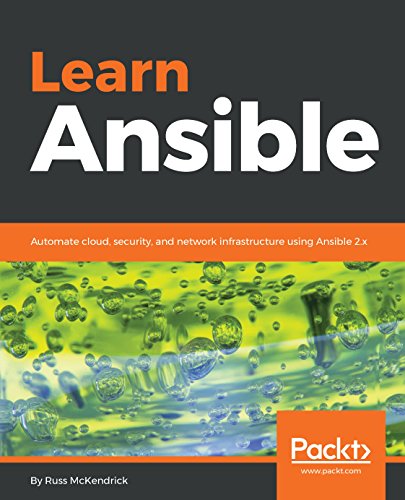
Learn Ansible
Run Ansible playbooks to launch complex multi-tier applications hosted on public cloudsKey FeaturesGain a fundamental understanding of Ansible and its featuresPerform configuration management, application deployment, and service orchestration with Ansible 2.xSimplify IT automation using Ansible with the help of tips and tricksBook DescriptionAnsible has grown from a small, open source orchestration tool to a full-blown orchestration and configuration management tool, developed by Red Hat.
Its powerful core modules cover a wide range of infrastructures, including on-premises systems and public clouds, operating systems, devices, and services, enabling it to manage pretty much your entire end-to-end environment. Thanks to its ease of use, Ansible is the first choice of IT automation tools among system administrators.This end-to-end practical guide will help you transition from a beginner to pro Ansible user. Starting with the installation and configuration, you’ll be introduced to Ansible playbooks. After getting a quick rundown of the essential Ansible commands, you’ll understand how to work with different Ansible modules for core IT automation tasks, such as infrastructure management, configuration management, and cloud deployment. Learn Ansible also covers aspects of hardening and securing your servers.By the end of this book, you’ll have complete understanding of Ansible and how you can use it in your own IT environment for efficient automation.What you will learnWrite your own playbooks to configure servers running CentOS, Ubuntu, and WindowsIdentify repetitive tasks and write playbooks to automate themDefine a highly available public cloud infrastructure in code to distribute your infrastructure configuration easilyDeploy and configure Ansible Tower and Ansible AWXExplore the use of community contributed rolesUse Ansible in your day-to-day role and projectsWho This Book Is ForIf you’re a system administrator or developer looking to transform your current workflows into repeatable playbooks using Ansible, this book is for you. No prior knowledge of Ansible is required.Table of ContentsAn Introduction to AnsibleInstalling and Running AnsibleThe Ansible CommandsDeploying a LAMP stackDeploying WordPressTargeting Multiple DistributionsThe core network modulesMoving to the CloudBuilding out a cloud networkHighly Available Cloud DeploymentsBuilding out a VMware deploymentAnsible Windows ModulesHardening Your Servers Using Ansible and OpenSCAPDeploying WPScan and OWASP ZAPIntroducing Ansible Tower and Ansible AWXAnsible GalaxyNext Steps with AnsibleAssessments
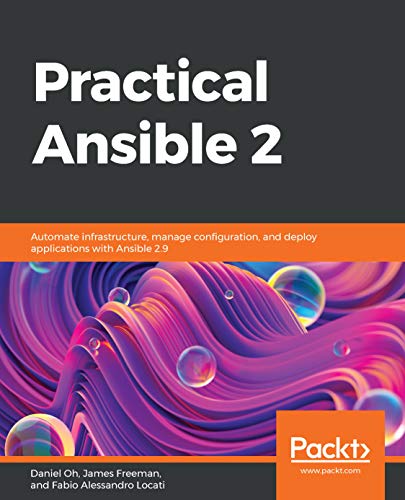
Practical Ansible 2
Leverage the power of Ansible to gain complete control over your systems and automate application deployment Key Features Use Ansible 2.9 to automate and control your infrastructure Delve into advanced functionality such as plugins and custom modules in Ansible Automate and orchestrate major cloud platforms such as OpenStack, AWS, and Azure using Ansible Book Description Ansible enables you to automate software provisioning, configuration management, and application roll-outs, and can be used as a deployment and orchestration tool.
While Ansible provides simple yet powerful features to automate multi-layer environments using agentless communication, it can also solve other critical IT challenges, such as ensuring continuous integration and continuous deployment (CI/CD) with zero downtime. In this book, you’ll work with Ansible 2.9 and learn to solve complex issues quickly with the help of task-oriented scenarios. You’ll start by installing and configuring Ansible on Linux and macOS to automate monotonous and repetitive IT tasks and get to grips with concepts such as playbooks, inventories, and network modules. As you progress, you’ll gain insight into the YAML syntax and learn how to port between Ansible versions. In addition to this, you’ll also understand how Ansible enables you to orchestrate multi-layer environments such as networks, containers, and the cloud. By the end of this Ansible book, you’ll be well – versed in writing playbooks and other related Ansible code to overcome just about all of your IT challenges, from infrastructure-as-code provisioning to application deployments, and even handling the mundane day-to-day maintenance tasks that take up so much valuable time. What you will learn Become familiar with the fundamentals of the Ansible framework Set up role-based variables and dependencies Avoid common mistakes and pitfalls when writing automation code in Ansible Extend Ansible by developing your own modules and plugins Contribute to the Ansible project by submitting your own code Follow best practices for working with cloud environment inventories Troubleshoot issues triggered during Ansible playbook runs Who this book is for If you are a DevOps engineer, administrator, or any IT professional looking to automate IT tasks using Ansible, this book is for you. Prior knowledge of Ansible is not necessary.Table of Contents Getting Started with Ansible Understanding the Fundamentals of Ansible Defining Your Inventory Playbooks and Roles Consuming and Creating Modules Consuming and Creating Plugins Coding Best Practices Advanced Ansible Topics Network Automation with Ansible Container and Cloud Management Troubleshooting and Testing Strategies Getting Started with Ansible Tower
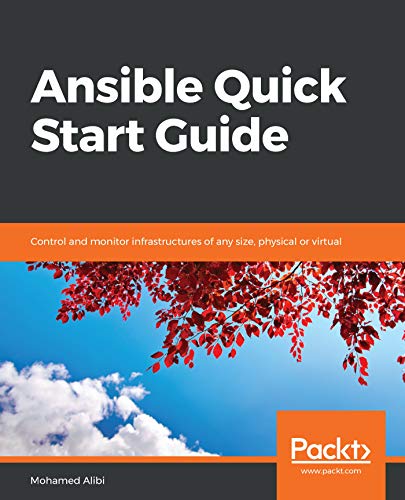
Ansible Quick Start Guide
Configure Ansible and start coding YAML playbooks using the appropriate modules Key Features Create and use Ansible Playbook to script and organise management tasks Benefit from the Ansible community roles and modules to resolve complex and niche tasks Write configuration management code to automate infrastructure Book Description Configuration Management (CM) tools help administrators reduce their workload. Ansible is one of the best Configuration Management tools, and can act as an orchestrator for managing other CMs.
This book is the easiest way to learn how to use Ansible as an orchestrator and a Configuration Management tool. With this book, you will learn how to control and monitor computer and network infrastructures of any size,physical or virtual. You will begin by learning about the Ansible client-server architecture. To get started, you will set up and configure an Ansible server. You will then go through the major features of Ansible: Playbook and Inventory. Then, we will look at Ansible systems and network modules. You will then use Ansible to enable infrastructure automated configuration management, followed by best practices for using Ansible roles and community modules. Finally, you will explore Ansible features such as Ansible Vault, Ansible Containers, and Ansible plugins. What you will learn Implement Playbook YAML scripts and its capacities to simplify day-to-day tasks Setup Static and Dynamic Inventory Use Ansible predefined modules for Linux, Windows, networking, and virtualisation administration Organize and configure the host filesystem using storage and files modules Implement Ansible to enable infrastructure automated configuration management Simplify infrastructure administration Search and install new roles and enable them within Ansible Secure your data using Ansible Vault Who this book is for This book is targeted at System Administrators and Network Administrators who want to use Ansible to automate an infrastructure. No knowledge of Ansible is required.Table of Contents What is Ansible? Ansible Setup and Configuration Ansible Inventory and Playbook Ansible Modules Ansible Automated Infrastructure Ansible Coding for Configuration Management Ansible Galaxy and Community Roles Ansible Advanced Features
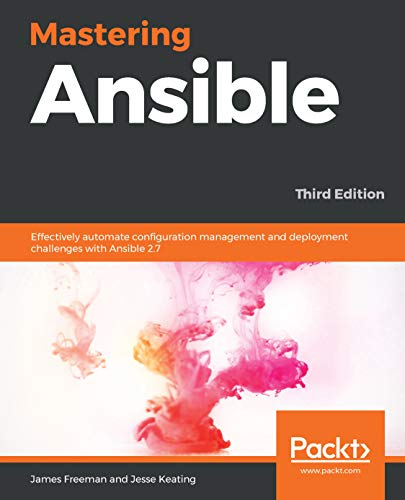
Mastering Ansible
Design, develop, and solve real-world automation and orchestration problems by unlocking the automation capabilities of Ansible.Key FeaturesTackle complex automation challenges with the newly added features in Ansible 2.7Book DescriptionAutomation is essential for success in the modern world of DevOps. Ansible provides a simple, yet powerful, automation engine for tackling complex automation challenges.This book will take you on a journey that will help you exploit the latest version’s advanced features to help you increase efficiency and accomplish complex orchestrations. This book will help you understand how Ansible 2.
Throughout this book, you will learn how to encrypt Ansible content at rest and decrypt data at runtime. Next, this book will act as an ideal resource to help you master the advanced features and capabilities required to tackle complex automation challenges. Later, it will walk you through workflows, use cases, orchestrations, troubleshooting, and Ansible extensions. Lastly, you will examine and debug Ansible operations, helping you to understand and resolve issues.By the end of the book, you will be able to unlock the true power of the Ansible automation engine and tackle complex, real- world actions with ease.What you will learnGain an in-depth understanding of how Ansible works under the hoodFully automate Ansible playbook executions with encrypted dataAccess and manipulate variable data within playbooksUse blocks to perform failure recovery or cleanupExplore the Playbook debugger and the Ansible ConsoleTroubleshoot unexpected behavior effectivelyWork with cloud infrastructure providers and container systemsDevelop custom modules, plugins, and dynamic inventory sourcesWho this book is forThis book is for Ansible developers and operators who have an understanding of its core elements and applications but are now looking to enhance their skills in applying automation using Ansible.
Hopefully you have found this list of Ansible books useful in your journey towards becoming a Ansible expert!
